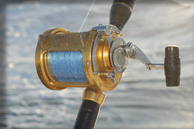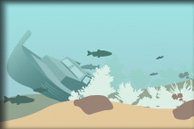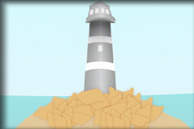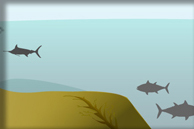Deep Sea Fishing
Deep sea or offshore fishing involves fishing out on the open ocean, far from shore where weather conditions and navigational charts should be carefully evaluated to ensure a safe trip. Learn which variables may affect your fishing experience along with the best fishing tackle and lures to use.
Best Deep Sea Fishing
Whether on a quest for a 500-pound bluefin tuna off the coast of Maine or a 1,000-pound blue marlin while on vacation in the Florida Keys, the best deep sea fishing trips provide anglers with a real adrenaline rush from the hard fighting, big game species that are eagerly encountered. While new technology in boats, motors, electronics, safety equipment and fishing tackle has made saltwater fishing more accessible than ever before, offshore fishing without a charter or guide is not recommended for beginners. If you are an intermediate or advanced angler seeking a challenge, get ready to venture out into the deep blue sea!
Deep Sea Fishing Tackle
 Due to the number of deep sea game fish species and fishing techniques for catching them, there are many different types of deep sea fishing rods, reels, gears and tackle that can be used. Offshore fishing may involve trolling with deep sea lures or live baits, jigging with lures or bottom fishing with baits. If you were deep sea trolling for sailfish, you might use the following tackle and gear as an example:
Due to the number of deep sea game fish species and fishing techniques for catching them, there are many different types of deep sea fishing rods, reels, gears and tackle that can be used. Offshore fishing may involve trolling with deep sea lures or live baits, jigging with lures or bottom fishing with baits. If you were deep sea trolling for sailfish, you might use the following tackle and gear as an example:
- A 6 to 7-foot medium action offshore fishing rod
- Heavy or large saltwater-specific baitcaster reel with high line capacity
- A 20-pound test monofilament line
- Some 6 to 10 feet of 40 to 80-pound test monofilament leader
- Live baits such as goggle eyes or threadfin herring
- 5/0 to 7/0 sized hooks
If you would prefer trying your luck at deep sea bottom fishing for grouper, here is an example tackle set up you can use:
- A 6-foot medium-heavy bottom fishing rod
- Heavy duty baitcaster reel
- A 50-pound test monofilament line
- A 80 to 100-pound test monofilament leader line
- Fish finder rig using a 7/0 circle hook and 3 to 16-ounce sinkers
- Cut bait such as squid or grunts
Deep Sea Fishing Tips
Once out into the ocean with your necessary fishing tackle, look for the suggested areas below to find fish. To locate some of the best deep sea fishing areas, get a fishfinder, GPS or a nautical map and follow the guide below. Follow these deep sea fishing safety tips.
Rocks, Reefs And Wrecks
 Rocks, reefs and wrecks offer some of the best deep sea fishing opportunities. These types of structures provide a haven for every species in the food chain and offer a place for fish to hide from the strong ocean currents. When fishing near artificial or natural reefs, consider that fish may be living in the structure or patrolling the outer edges as far as 100 yards from the reef. Reef dwelling fish can usually be enticed to bite by sending a vertical jig to the bottom and quickly working it back to the boat.
Rocks, reefs and wrecks offer some of the best deep sea fishing opportunities. These types of structures provide a haven for every species in the food chain and offer a place for fish to hide from the strong ocean currents. When fishing near artificial or natural reefs, consider that fish may be living in the structure or patrolling the outer edges as far as 100 yards from the reef. Reef dwelling fish can usually be enticed to bite by sending a vertical jig to the bottom and quickly working it back to the boat.
TIP: For reef dwelling species such as blackfish, grouper or snapper, consider anchoring the boat in place with the engines and then drop baits down to the structure. For high-speed predatory fish such as tuna, wahoo and billfish, try fast-trolling fishing lures and slow-troll live baits.
Towers And Navigational Aids
 Manmade structures including towers and navigational aids are valuable to both fish and anglers, but for different reasons. Some species seek refuge deep inside the structure while others prefer to patrol the perimeter. In order to best determine where the fish are holding, use a fishfinder or recreational sonar. You'll also want to be sure to check into any local regulations that may limit access before fishing a tower or navigational aid.
Manmade structures including towers and navigational aids are valuable to both fish and anglers, but for different reasons. Some species seek refuge deep inside the structure while others prefer to patrol the perimeter. In order to best determine where the fish are holding, use a fishfinder or recreational sonar. You'll also want to be sure to check into any local regulations that may limit access before fishing a tower or navigational aid.
TIP: Troll natural baits or artificial fishing lures around a tower or buoy to get the attention of predatory fish.
Hills And Sea Mounts
 Submerged mountain ranges and hills divert the current and create ideal spots for offshore fishing. Sea mounts can provide fish with more favorable water conditions as water temperature, light level or salinity may be out of the range for a particular species at the bottom of the sea mount, but just right at the top. When fishing around these structures, always look for variations in the surface conditions such as ripples, rips or tide lines that may indicate changes in water temperature, salinity, clarity or current.
Submerged mountain ranges and hills divert the current and create ideal spots for offshore fishing. Sea mounts can provide fish with more favorable water conditions as water temperature, light level or salinity may be out of the range for a particular species at the bottom of the sea mount, but just right at the top. When fishing around these structures, always look for variations in the surface conditions such as ripples, rips or tide lines that may indicate changes in water temperature, salinity, clarity or current.
TIP: Structures can stretch for miles, so the best deep sea fishing tackle for fishing sea mounts and hills is natural or artificial baits. Fish will often hold in the same area on a sea mount or hill, so try trolling; when you hook one fish, mark the spot on the GPS and return to the same spot to find more fish.
Canyons And The Continental Self
 The deep canyons, gorges and cliffs that mark the Continental Shelf would put any land-based mountain range to shame and are other good places to look for fish. Locate any variations in current or water temperature that intersect the shelf. When the variations in structure, current and temperature force nutrient-rich water up from the deep to fuel the entire food chain, pelagic sport fish like billfish and wahoo will hunt the upper half of the water column. Giants such as grouper, snapper and halibut linger at the bottom. Birds above and baitfish are generally good indicators of activity, but often the fish will be visibly feeding on the surface.
The deep canyons, gorges and cliffs that mark the Continental Shelf would put any land-based mountain range to shame and are other good places to look for fish. Locate any variations in current or water temperature that intersect the shelf. When the variations in structure, current and temperature force nutrient-rich water up from the deep to fuel the entire food chain, pelagic sport fish like billfish and wahoo will hunt the upper half of the water column. Giants such as grouper, snapper and halibut linger at the bottom. Birds above and baitfish are generally good indicators of activity, but often the fish will be visibly feeding on the surface.
TIP: The best deep sea fishing techniques involve trolling natural or artificial baits. If bottom fishing, try using fishing lures such as large jigs or heavy-duty rigs to get the baits down deep.
Kelp Forests And Beds
Kelp forests occur in temperate and polar coastal oceans around the world but in the United States they are commonly found along the California coastline. Large congregations of kelp plants are referred to as kelp forests whereas smaller patches are known as kelp beds. These underwater forests have an incredibly high density of kelp plants which are a type of rapidly growing brown macroalgae. The forests and beds created by the kelp provides one of the most productive and dynamic ecosystems on the planet. The large stature of each kelp plant creates a very broad, three-dimensional habitat for large fish to hide and seek shelter as well as ambush their prey. When fishing kelp forests, anglers should typically start by free lining live or dead baits from an anchored or drifting boat. If you don’t get any bites by free lining your baits, then you should try to gradually add weight to your rig until you start to get the fish to bite.
The Open Ocean
Fishing in the open ocean is an endeavor that only confident and experienced anglers should attempt. To successfully and safely target pelagic fish species that live in the open ocean, specialized tackle and boats are typically required. The easiest way to experience offshore angling for those anglers who don’t have larger boats is to book a fishing charter.
When researching charter boats that you’re thinking of hiring, be sure to ask plenty of questions before booking your trip. Ask about the length of the trip, what species you’ll be targeting, how may people can the boat hold, will the trip be private or open to other customers and anything else you may think of. If you would like to keep any of your catch for dinner, be sure to clarify what the boat’s policy is on fish that are caught. Depending on where you’re booking a charter, some charter crews have a policy of taking fish to local auctions to sell fish that the anglers catch. Always remember that you don’t ever have to keep a fish in order to get it mounted. Exact replicas of fish can be made with only a few pictures.
Open ocean fishing takes place all over the country but certain regions require a farther boat ride offshore in order to find good fishing grounds. For example, the best deep sea fishing in Eastern states typically require a longer trip out to the fishing grounds (with the exception of Southern Florida) whereas states along the Pacific Ocean have steeper dropoffs and require a much shorter ride to find deeper waters.
Open ocean pelagic species of fish include tunas, billfish, dolphin, wahoo and some shark species.
Rocky Sea Floor
Out in the open ocean, there is very little structure. Consequently, many game fish congregate around underwater areas of relief or areas that provide shelter. While not as dense and diverse as a reef's ecosystem, the rocky bottom still provides protection for many species of baitfish and plankton. They also allow for places for predators to ambush prey. All of these factors make rocky areas a great place to fish. The best deep sea fishing methods for fishing these areas include deep dropping and jigging.
Coastal Waters
In coastal areas, closer to shore, the ocean bottom may have sections of exposed rock, coral or debris. These areas of uneven bottom provide a great ambush spot for predatory fish as well as crevices for smaller fish to take shelter. Fish live at all depths in coastal water and many stay close to the bottom. Many feed near cover, such as a rock or a coral reef, where they can ambush prey. Other fish roam at all depths of the water column, searching for an easy meal. Most saltwater anglers do their best deep sea fishing in coastal waters because there are dozens of different fish species there, and these areas are often very easy to access. Many marine fish migrate up and down the coastline seasonally. Smart anglers monitor water temperatures, winds, currents, seasons and tides to determine which species they should target.
Find the best times to saltwater fish in our next section.
KEEP LEARNING

How to Tie the Non-Slip Loop Knot
The non-slip loop knot is a popular and reliable choice for securing hooks, lures, and other tackle to your fishing line.
LEARN MORE

Socials
Take me fishing social media links
LEARN MORE

TakeMeFishing x Teen Vogue
Join us on a creative journey as fashion designer Ahmrii Johnson walks us through her collaborative vision and process with Teen Vogue and fashion brand, Rentrayage, to create a special piece.
LEARN MORE


.png?lang=en-US&ext=.png)